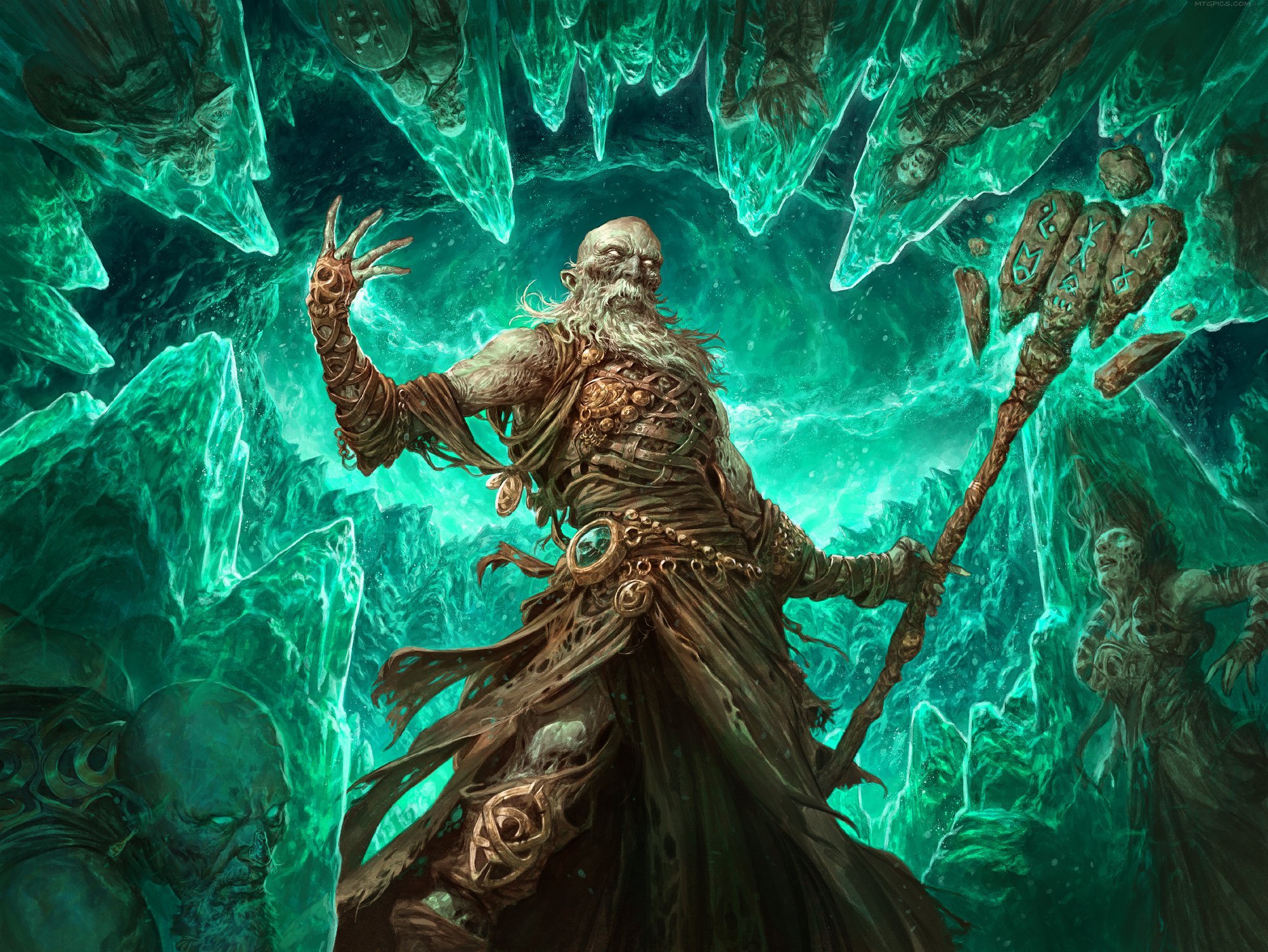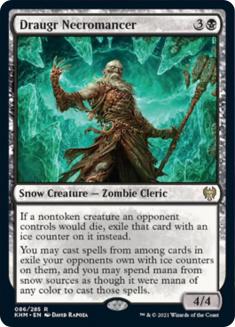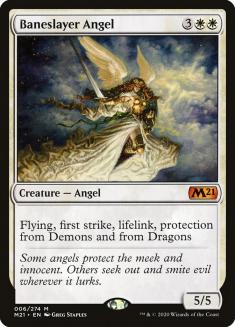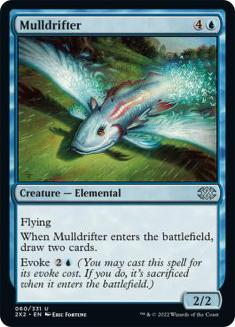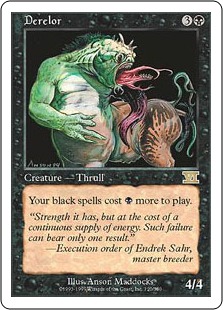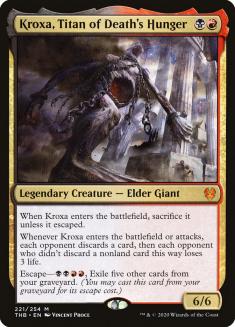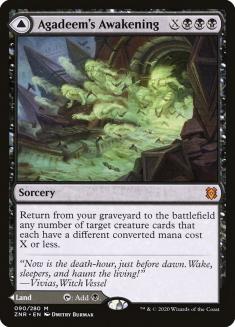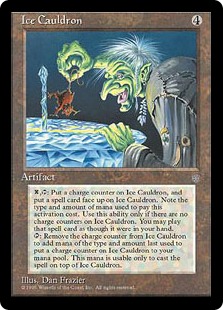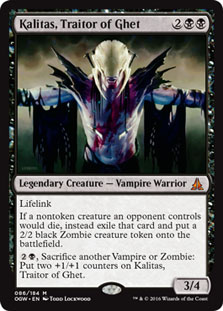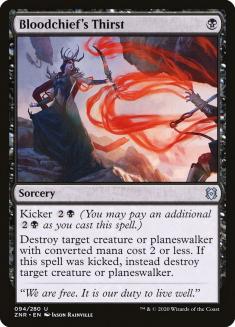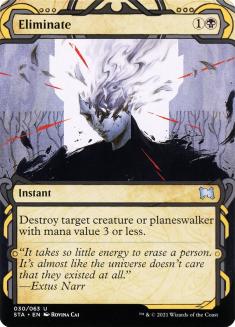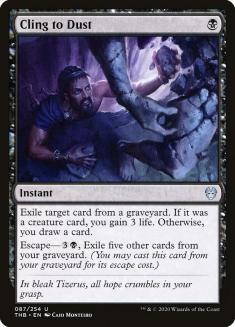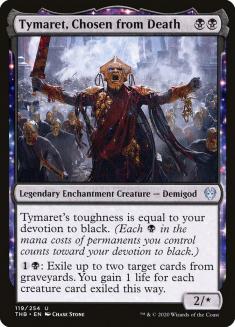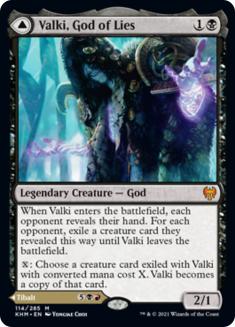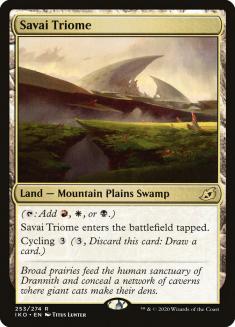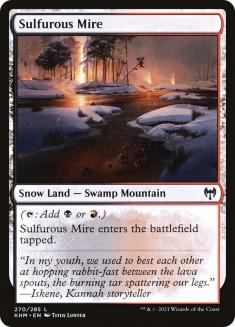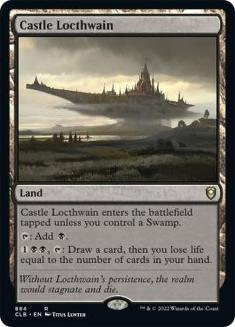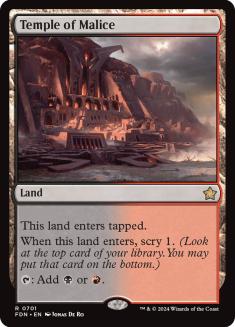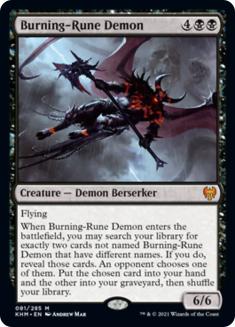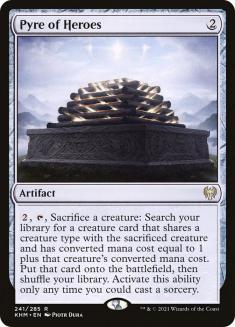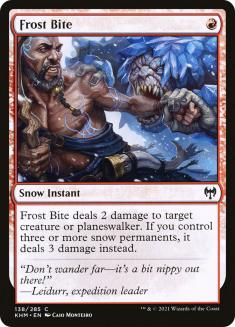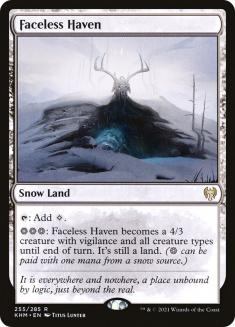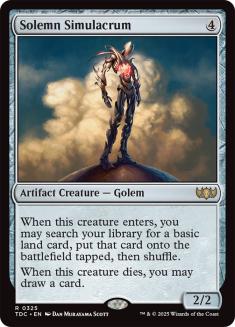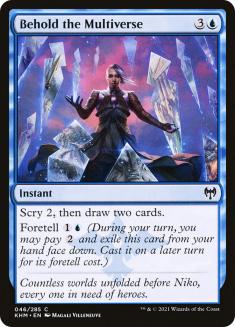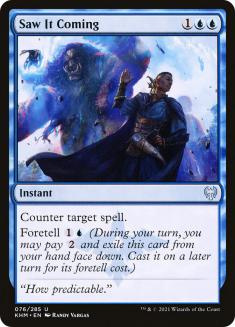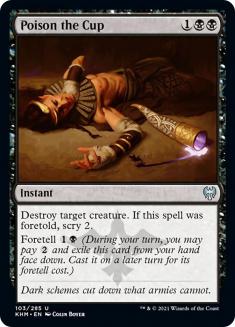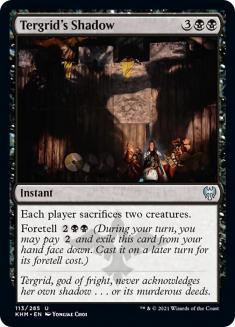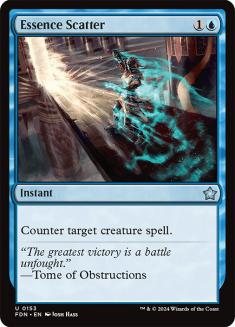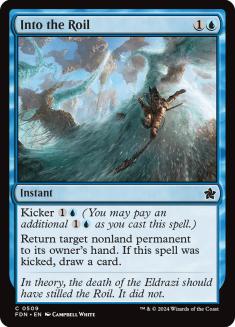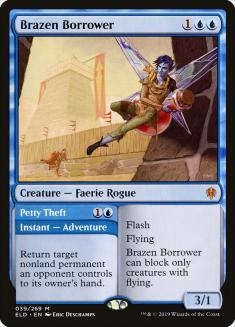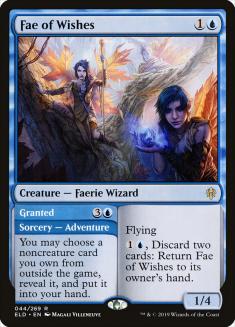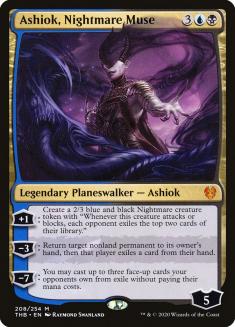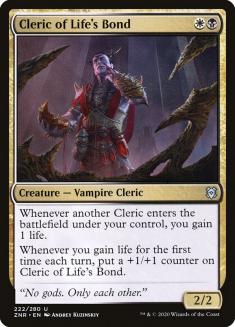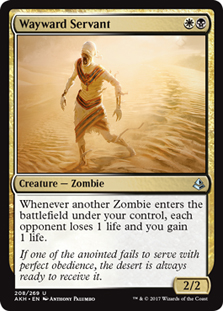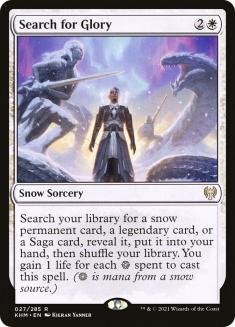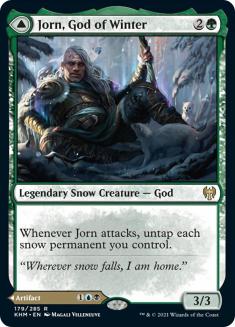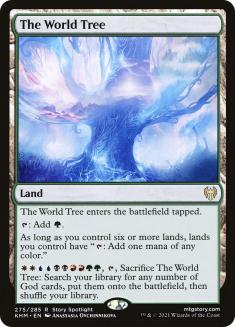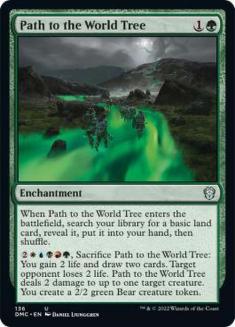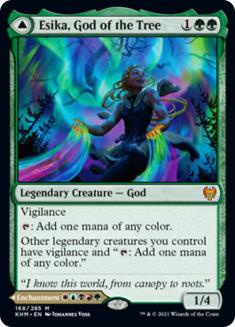Kaldheim Night Kings know what’s up.
Draugr Necromancer is a Baneslayer Angel, to be sure – a creature whose value comes from the influence it generates as an active game piece being used (rather than a Mulldrifter, whose influence is generated when it’s cast).
In evaluating Draugr Necromancer, we can of course, begin with the 4/4 body for 3B. While not good enough by modern standards, it’s kind of an interesting inflation of vanilla rates, without even a second black mana symbol in the cost or legendary as a drawback.
There once was a time when mighty Derelor was splashed into decks for a chance to get a 4/4 for four with only a “modest” drawback.
As for the abilities, they are kind of all one ability really, just with a few facets to it. To begin with, your opponent’s (nontoken) creatures get exiled when they die, impacting the value of creatures that die when you use them or have recursive abilities, as well as cards that can bring creatures back from the graveyard.
While putting an ice counter on the creature in exile doesn’t mean much, it does mean later Draugr Necromancers can cast the cards exiled by the earlier ones.
Ice Cauldron uses charge counters, sorry. No killer combos here.
Draugr Necromancer also lets you cast the exiled cards, which is a pretty huge game, with snow mana letting you fix your colors. The fixing coming from snow lands is interesting, since it does mean we’re gonna want some, but we don’t necessarily need to be all-in. Most creatures only have one or two mana symbols in their costs anyway.
In many ways, this is like drawing a card every time an opponent’s nontoken creature dies, and in some ways, it’s even better, given that you’re always drawing business. While it’s not going to do much against someone without creatures, the Necromancer’s ability to take over the game against someone that does is very big.
While not the same kind of threat as Kalitas, Traitor of Ghet in terms of stabilizing, Draugr Necromancer does actually have a lot of similarities in how it can take over if left unchecked.
What does it take to make Draugr Necromancer work?
Well, all you really need is to make sure you can kill creatures effectively. Note: this doesn’t just mean “deal with them.” You really do have to kill them, or else Draugr won’t trigger. This doesn’t mean cards like Extinction Event are completely out of the question, but they are weaker than they’d normally be.
Likewise, cards that scale off creatures in your opponent’s graveyard have their values somewhat impacted (though this impact might be minor, particularly if you can still use your own graveyard).
Draugr Necromancer doesn’t require you to be all-in on some linear plan, however. It can make a great addition to a “good cards” deck that’s just kind of a bunch of good cards and a reasonable mana curve. For instance:
Creatures (20)
- 1 Murderous Rider
- 4 Bonecrusher Giant
- 1 Tymaret, Chosen from Death
- 1 Phoenix of Ash
- 2 Kroxa, Titan of Death's Hunger
- 2 Terror of the Peaks
- 2 Nighthawk Scavenger
- 3 Valki, God of Lies
- 1 Goldspan Dragon
- 3 Draugr Necromancer
Lands (23)
Spells (17)

What’s this deck do? Well, it just kind of plays good cards, you know?
Valki is a great form of early or tactical disruption, a potential source of card advantage, and a very powerful late-game plan on account of Tibalt, Cosmic Impostor being a nice option at seven mana (given how much less risk he carries, since you can cast him as Valki on Turns 2 through 6, no problem).
Valki does exile the creature, however, but it’s not like it isn’t giving you a chance to steal it anyway. Either Valki can transform into it or they kill Valki and get it back, and then you have a chance to steal it later.
The question of Savai Triome versus Sulfurous Mire is an interesting one. After all, they are both always tapped lands and do both help untap any Castles you might play.
The question is whether the option to cycle it for three is worth more or less than the option to use it as a rainbow land with Draugr. If you had other cards that cared about snow mana, the needle could easily move quickly. To start with, I just went with fourteen sources of snow mana, since that’s often a floor on how many sources of a color you’d want in a deck trying to get two mana of that color by Turn 5 (the earliest you can realistically use Draugr Necromancer here).
Both of these options have to generate enough value to be worth passing on Temple of Malice, but it doesn’t take much Castle Locthwain action to make things worthwhile.
Burning-Rune Demon could actually be an option and is a sweet design; however, Valki has so much less opportunity cost, as far as expensive threats go, that it seems hard to justify Burning-Rune Demon on the gate. Maybe it’s sweet finding both Kroxa, Titan of Death’s Hunger and Phoenix of Ash or Skyclave Shade, but I’m kind of more inclined to try the Burning-Rune Demon in a Golgari-based deck with a lot of graveyard action and some ways to find it when you want it.
With the right support, Pyre of Heroes might be a great fit for Draugr Necromancer anyway, and if we see the right kind of multi-type or changeling five-drop, could also be a way to access a lone copy of Burning-Rune Demon (and potentially go even further up the chain to some seven-drop).
While Frost Bite is a fine card, it’s not really bringing anything to the table that we don’t already get from our black cards. It’s worth noting that Draugr is a snow permanent, If we did want to explore Draugr Necromancer in a deck with more snow-incentives, we might try looking to Faceless Haven and Blood on the Snow.
Faceless Haven is a great creature-land if you’re that long on snow mana. Blood on the Snow is a more speculative build-around (unless you’re happy using it as a mediocre, over-costed sweeper), but it does have some exciting promise with Draugr Necromancer. You can sweep the battlefield with Blood on the Snow while you have a Draugr Necromancer and then have the Necromancer come back, able to then go on to cast the iced creatures you just killed whenever you’ve got the mana.
Besides, Solemn Simulacrum is kind of a sweet way to set up Blood on the Snow, both in getting you snow basics and letting you play it ahead of schedule. Then getting it back is great, giving you lots of card advantage and helping you get to Ugin faster.
Creatures (10)
Planeswalkers (4)
Lands (33)
Spells (33)
- 2 Negate
- 1 Witch's Vengeance
- 4 Omen of the Sea
- 1 Cling to Dust
- 2 Elspeth's Nightmare
- 3 Extinction Event
- 4 Heartless Act
- 4 Mazemind Tome
- 4 Behold the Multiverse
- 4 Saw It Coming
- 2 Poison the Cup
- 2 Blood on the Snow
Sideboard

While Draugr Necromancer isn’t a natural fit with Yorion, Sky Nomad, Yorion does work well with Blood on the Snow. Maybe just don’t blink the creatures you steal with Draugr Necromancer, though.
Even with relatively few creatures and planeswalkers to get back, having Yorion as your companion ensures you’ve got at least one, and getting to reblink your artifacts and enchantments is a lot of potential value.
The foretell package available to Dimir Control decks is pretty interesting. First and foremost, Behold the Multiverse just seems excellent.
Behold the Multiverse is a Glimmer of Genius that, instead of giving you two energy, gives you the option to foretell it very efficiently. Once you’re foretelling Behold the Multiverse, it adds some interesting gameplay to cards like Saw It Coming and Poison the Cup. After all, was it a card draw spell you just exiled, or powerful interaction?
While it’s not out of the question that we might want Tergrid’s Shadow, it is kind of overcosted, and we’re long on sweepers anyway between Extinction Event and Blood on the Snow. And that’s to say nothing of Witch’s Vengeance, which might see a resurgence, given the tribal elements of Kaldheim and how much more likely it is that it will be able to kill multiple threats.
While the above list does feature some permission, it passes on Essence Scatter because of Draugr Necromancer. We really do have a lot of incentive to let our opponent’s creatures resolve and then kill them, rather than counter them on the way in. It doesn’t mean we can’t play some hard counters like Saw Tt Coming, but the decrease in marginal utility hits Essence Scatter hardest.
Likewise, bounce has a little less utility here than just creature kill. We might still want some, but it’s a little less good than it’d normally be. Brazen Borrower isn’t very good at blocking, anyway; and it isn’t necessarily going to be able to die in service of something useful, as we’d like. In fact, we’ve actually got to be careful about opposing bounce spells and not just reanimate any and everything we possibly can (since reanimating a creature that can beat us if bounced might lead to snatching defeat from the jaws of victory).
Besides, reanimating it isn’t even all that productive compared to something that scales better as a permanent later on, such as Fae of Wishes.
How much Blood on the Snow should inform our threat suite remains to be seen, but the number of cards that have their values at least somewhat altered is quite high. For instance, consider Murderous Rider and Shark Typhoon.
Murderous Rider doesn’t reliably go to the graveyard to come back, unless you have ways to discard it or self-mill or some such. Shark Typhoon makes a token we can’t reanimate, of course, and even the threat of casting it as an enchantment is worth less to us, as we already have sixes in Blood on the Snow.
Even the balance between Ashiok, Nightmare Muse and Ugin, the Spirit Dragon is called into question. Ugin’s abilities to sweep the battlefield has less novelty when we’ve got Blood in the Snow helping, whereas Ashiok, Nightmare Muse can actually return from the graveyard by Blood in the Snow, and very effectively.

Port of Karfell is actually a seven, all told, since tapping the land itself also costs you a mana. While the opportunity cost of Port of Karfell is pretty low, it is tapping into the same space a lot of other cards in our deck do (i.e. let us spend a mana or get a mana, depending on the utility of the option in a given battlefield). How strong it ends up being will largely depend on how reliably we’re going to have a creature in our graveyard by the time we’d want to activate this thing. We don’t need that many or anything, since you do only have to have one in your graveyard so far, and you even get four extra shots if you’re desperate (or for more selection).
As for Draugr Necromancer’s use in the other colors, there are some other aspects to the card that we might consider utilizing.
In a white deck, maybe we can take advantage of Draugr Necromancer’s Cleric creature type (or even Zombie creature type at some point).
I don’t think we’re likely to be in the market for such a thing, but Draugr Necromancer could be a fine Search for Glory target.
In a green deck, we might value the Necromancer’s snow-ness with a card like Jorn, God of Winter, but that’s really not the highest-leverage interaction.
More likely, we could capitalize on green’s ability to give us all five colors and effectively circumvent the snow conditions entirely.
Cards like The World Tree, Path to the World Tree, and Esika, God of the Tree really add a lot more options and support for a five-color green manabase.
While I don’t think Draugr Necromancer is a Top 5 card in the set or anything, it’s got some potential and a high ceiling, and it has enough layers to it that figuring out the best way to utilize it seems a promising and rewarding puzzle to solve.

